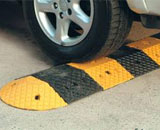
Construction sites, heavy traffic times, and weather hazards can make roads dangerous and speed ramps are playing an important role in helping traffic to move more slowly and safely.
Known as traffic calming devices, speed ramps or speed bumps are used both in residential and commercial settings. Designed to slow the speed of vehicles to safer speeds of fewer than 20 mph, speed ramps are usually constructed of high-density rubber. These systems have been employed on European roads for decades, and have proven to make both driving and walking safer. Today, traffic-calming measures like the speed bump are in use in North America and around the world. As a result, thousands of traffic accidents and fatalities have been avoided.
In Residential Neighbourhoods
Traffic calming speed bumps, when employed in a residential setting have made them safer and more pleasant to live in. The reduced volume and speed of traffic that speed ramps offer has reduced not only the severity of pedestrian crashes, but their numbers as well. With speed ramps, drivers are compelled to slow down to speed that will allow for quicker reaction to those situation, which may arise unexpectedly, such as a neighbourhood dog running across a street.
In Commercial Settings
Speed bumps employed in commercial settings have proven to greatly reduce employer liability. When equipment traffic is reduced to an acceptable level, all employees, whether on machines or walking the grounds can be assured of a safer journey. A workplace that's safe to work in can mean less stress for employees, and more focus where it needs to be; on the task at hand.
How Slower Vehicle Speeds Increase Safety and Save Lives
When a vehicle is traveling at a slower speed, the probability of injury or fatality is also automatically lowered. In fact, by reducing traffic speed by only 1 mph, collisions between vehicles can be reduced by as much as 5 percent and fatalities by over 5%. If a driver is moving at a speed of 40 mph and sees a pedestrian 100 feet ahead, they will likely only be able to reduce their speed to 38 mph before impact occurs. However, when that same driver is going only 25 mph, they can avoid impact altogether.
Many types of speed ramps are constructed in such a way as to stand up to long-term, regular traffic of vehicles of all types. As well, these ramps also tend to be low maintenance and offer very little chance that a driver's vehicle will become damaged from driving over them. However, they provide the driver with enough of a jolt that they are compelled to slow down. Speed ramp types can interlock so as to cover a wide street, with many being designed to be able to be expanded upon should the need arise. There is no doubt that the speed ramp system has been a significant participant in the success of traffic calming measures.
The Workplace Depot Speed Ramps
The Workplace Depot sells a range of 5 and 10 mph speed ramps that are made of heavy duty rubber and come with fixing bolts for concrete and tarmac. Some like our Speed Hump have a central slot enabling cables to run underneath it or you can opt for the Sleeping Policeman. This has two channel (35W and 30H) and is 1830mm long. We also sell our Speed Bump kit which is ideal for residential areas, school zones and entrances - they are highly visible and made from recycled rubber.
Posted in Product Updates